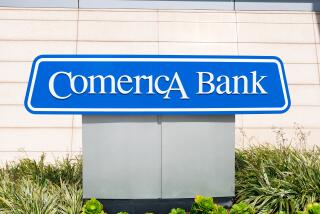Bank Insurance Fund Falls Again, FDIC Says : Banking: The second straight annual drop leaves the reserve at about half the level required by law.
- Share via
WASHINGTON — The Federal Deposit Insurance Corp. said Tuesday that its bank insurance fund, which insures 13,200 banks, fell for the second consecutive year to about half the level the law requires.
The fund that backs up the nation’s federally insured bank deposits declined by $851 million in 1989 to $13.2 billion, when 207 banks failed or required government assistance to remain open, the FDIC said in a preliminary, unaudited financial report.
The 1989 loss was down from a $4.24-billion loss in 1988 when a post-Depression record of 221 banks failed.
While last year’s loss was less severe than the 1988 drop, the report said “the continued high level of closed or assisted banks is having a detrimental impact on the fund,” which insures all bank deposits up to $100,000.
The fund’s $13.2-billion level at year-end represented 0.7% of the value of all insured bank deposits, a little more than half the 1.25% level required by the savings and loan bailout law enacted last summer.
The loss results because the FDIC was forced to pay more to take over the failed banks than it received in insurance premiums paid by healthy banks.
FDIC Chairman L. William Seidman predicted that the bank insurance fund could return to profitability this year if it is not forced to take over any large banking institution.
“Although the bank fund declined in 1989, the drop was considerably less severe than the previous year,” Seidman said.
A heavy blow to the fund in 1989 occurred with the failure of MCorp. Regulators have estimated that the failure of the Dallas-based bank holding company could end up costing $2 billion, making it the second costliest bank failure in history.
Seidman predicted that bank failures could decline to 150 to 175 this year, still a large number compared to the 10 bank failures in 1980.
Seidman said his forecast was a very rough estimate based on the rate banks have been failing so far.
“Much depends on future interest rates and future real estate markets,” he told reporters.
A financial institution becomes insolvent when the value of its assets, primarily in the form of loans it makes, drops below the level of its liabilities, represented by its customers’ deposits.
Despite the back-to-back losses, analysts said they believed that the FDIC would be able to escape the sort of trouble that befell the Federal Savings and Loan Insurance Corp., the sister fund set up to insure deposits at savings and loan institutions.
Because of the record number of S&L; failures, the FSLIC became insolvent, requiring the government to step in with the costliest bailout in U.S. history.
Robert Litan of the Brookings Institution said the FDIC situation deserves close attention to keep it from escalating into another S&L; crisis.
“The key lesson we learned is don’t delay,” he said. “The thrift crisis got out of hand because Congress and the regulators did not act.”
More to Read
Inside the business of entertainment
The Wide Shot brings you news, analysis and insights on everything from streaming wars to production — and what it all means for the future.
You may occasionally receive promotional content from the Los Angeles Times.










